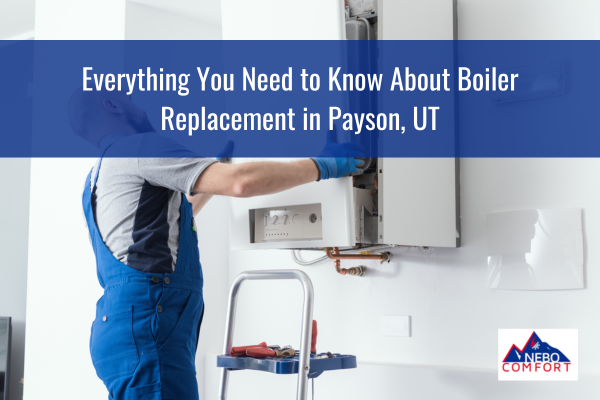Utah’s winters can be harsh. As the snow falls and temperatures plummet, a reliable furnace becomes essential for keeping your home comfortable and your family warm.

But what happens when your trusty furnace starts showing signs of age or struggles to keep up with the demands of winter? It might be time to consider a furnace replacement.
While furnace repairs can sometimes extend the lifespan of your existing system, there comes a point where replacement is the more cost-effective and efficient option. Here in Utah, understanding furnace replacement costs becomes crucial for budgeting and making informed decisions about your home’s heating system. This comprehensive guide from Nebo Comfort, a trusted HVAC contractor serving Utah, will explore the factors that influence furnace replacement costs, offer average price ranges, and provide tips for getting the best value on your new furnace.
Factors Affecting Furnace Replacement Costs in Utah
Several factors contribute to the final cost of your furnace replacement project in Utah. Here’s a breakdown of the key elements to consider:
- Furnace Type and Efficiency: Furnaces come in various types, each with its own efficiency rating. High-efficiency furnaces, like those with AFUE ratings exceeding 90%, cost more upfront but save you money on energy bills in the long run. Conversely, less efficient models are cheaper to buy but have higher operating costs.
- Furnace Size: The size of your furnace, measured in British Thermal Units (BTUs), needs to match the heating demands of your home. A furnace that’s too small won’t adequately heat your space, while an oversized unit will cycle on and off more frequently, reducing efficiency and increasing energy costs.
- Existing Ductwork: Your existing ductwork plays a vital role. If your current ductwork is in good condition and compatible with the new furnace, the installation is simpler. However, if the ductwork requires significant repairs or replacement, it can significantly increase the overall cost.
- Labor Costs: Labor costs can vary depending on the HVAC contractor you choose, their experience level, and the complexity of the installation. Getting quotes from multiple reputable companies allows you to compare labor rates and ensure you’re getting a fair price.
- Permits and Inspections: Depending on your location in Utah, obtaining permits and scheduling inspections might be necessary for furnace replacement. These costs can vary slightly depending on your municipality.
Average Furnace Replacement Costs in Utah
With the factors mentioned above in mind, it’s important to understand that the final cost of your furnace replacement can vary significantly. However, here’s a general breakdown of average furnace replacement costs in Utah:
- Basic Gas Furnace (80% AFUE): $2,500 – $4,500
- Mid-Efficiency Gas Furnace (85%-90% AFUE): $3,500 – $5,500
- High-Efficiency Gas Furnace (90%+ AFUE): $4,500 – $7,000+
Additional Costs to Consider
While the furnace itself is the primary expense, there might be additional costs associated with your furnace replacement:
- Removal and Disposal of Old Furnace: Most HVAC companies will factor this cost into their quotes.
- Thermostat Upgrade: Replacing your old thermostat with a programmable or smart thermostat can improve efficiency and comfort.
- Air Filter Upgrade: Upgrading your air filter system can enhance indoor air quality and protect your new furnace.
- Ductwork Repairs or Replacement: As mentioned earlier, significant ductwork repairs or replacements can significantly increase the overall project cost.
Book a call with our team to go over your optionsIs it time to replace your furnace?
Financing Options for Furnace Replacement
Replacing your furnace is a significant investment. Fortunately, many HVAC contractors offer financing options to help make the process more manageable. Consider exploring financing options to spread the cost of your new furnace over a more extended period.
Tips for Getting the Best Value on Your Furnace Replacement
Now that you understand the factors influencing furnace replacement costs, here are some tips to ensure you get the best value for your money:
- Get Multiple Quotes: Don’t settle for the first quote you receive. Obtain estimates from at least 3-4 reputable HVAC contractors in your area.
- Compare Apples to Apples: When comparing quotes, ensure you understand the type of furnace, its efficiency rating, and any additional services included.
- Ask About Rebates and Tax Credits: Utility companies and government programs often offer rebates and tax credits for installing high-efficiency furnaces. Take advantage of these incentives to lower your upfront costs.
- Consider Your Needs and Budget: Don’t overspend on features you don’t need. Choose a furnace that meets your home’s heating requirements and aligns with your budget.
- Focus on Long-Term Value: While a less efficient furnace might be cheaper upfront, remember that it will cost you more in energy bills over its lifespan. A high-efficiency furnace, although more expensive initially, can save you money on energy costs in the long run.
- Check for Warranties and Maintenance Plans: Ensure the furnace comes with a comprehensive warranty and inquire about extended warranty options. Additionally, consider purchasing a maintenance plan to keep your new furnace running efficiently and help prevent costly repairs.
Choosing the Right HVAC Contractor in Utah
Selecting the right HVAC contractor to handle your furnace replacement is crucial. Here are some factors to consider when choosing a contractor:
- Experience and Expertise: Look for a contractor with a proven track record and experience in furnace installation.
- Licenses and Certifications: Ensure the contractor is licensed and certified to operate in Utah.
- Customer Reviews and Testimonials: Read online reviews and ask for references to gauge customer satisfaction.
- Warranty and Guarantees: Inquire about the contractor’s warranty policies and any guarantees they offer.
- Promptness and Professionalism: Assess the contractor’s responsiveness, communication skills, and overall professionalism.
Conclusion
Replacing your furnace is a significant investment, but it’s essential for ensuring your home’s comfort and energy efficiency. By understanding the factors that influence furnace replacement costs, getting multiple quotes, and choosing a reputable HVAC contractor, you can make an informed decision and get the best value for your money.
Nebo Comfort, a leading HVAC company in Utah, is dedicated to providing top-quality furnace replacement services. With their expertise and commitment to customer satisfaction, Nebo Comfort can help you find the perfect furnace for your home and ensure a smooth installation process. Contact them today to schedule a free consultation and get started on your furnace replacement project.






